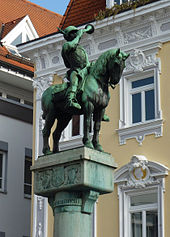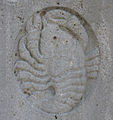Postmichel fountain
The Postmichelbrunnen in Fischbrunnenstrasse in Esslingen am Neckar is a fountain that illustrates the legend of Postmichel.
Say of Postmichel
content
One autumn morning in 1491, Amandus Marchthaler, a citizen of Esslingen, was found murdered and robbed on the Esslinger Steige near Stuttgart . The perpetrator could not be determined, the property of the unmarried victim was inherited by his nephew. Years later, the messenger rider Michel Banhard from Deggingen discovered a ring that had belonged to Marchthaler near the crime scene and put it on his finger in order to later give it to the responsible office as a lost property. Before he could put this into practice, however, the ring in the Esslinger Botenherberge was recognized as Marchthaler's property and Michel Banhard was suspected of being a murderer, arrested and tortured. In the end he made a confession in order to avoid the torture caused by death and was supposed to be beheaded by the Stuttgart executioner at the place of execution in the direction of Oberesslingen . As a last mercy, he asked to ride his white horse to the place of execution and blow his horn. He was allowed to do so. In front of the house of the murder victim's nephew, he blew the last bit on his horn and accused the resident of not standing up for him during the trial. He also told the executioner that the real murderer had not yet been found.
At the moment when Michel Banhard was beheaded, the sound of hoofs and horn blowing could be heard on the road to Stuttgart. Likewise, horn sounds rang out on the following St. Michaels Night both in the yard of Marchthaler's nephew and in front of the executioner's house in Stuttgart, and a rider on a white horse who carried his head under his arm and poked his horn was heard in both places seen. This appearance of the headless rider was repeated every year on Michaelsnacht, even after the murdered man's nephew had left Esslingen to avoid it. He later returned to the city and only shortly before his death confessed in confession that he himself had attacked and murdered his uncle.
According to the story in the Stuttgart city bell, a cross with an inscription that can no longer be interpreted in today's Stuttgart Wagenburgstrasse commemorated the murder of Amandus Marchthaler. The penitential cross , now translocates , really gave it. However, its establishment had completely different, albeit unknown reasons.
Lore
The story "The stone cross on the Eßlinger Steige near Stuttgart" appeared in several episodes in March 1845 in the Stuttgarter Stadt-Glocke , an maintenance sheet published by Johann Gottlieb Munder (1802-1870). It is unclear whether this or his brother, Pastor Wilhelm Friedrich Munder, wrote the prose text of the fictitious story. The last sentence of the story reads: This stone cross, to which the old legend is connected, that Postmichel rides through the haystack with his head under his arm at midnight, can still be seen on the spot, but it is currently threatened with doom, which is would be very regrettable, since it is the oldest known memorial stone around Stuttgart and deserves preservation . Johann Gottlieb Munder published the poem "Der Postmichel" as early as 1844 in a volume of poetry and in 26 stanzas. Here he added "Stuttgart Ammenmärchen. Time 1496". The table of contents shows that Munder himself wrote the poem as early as 1834. All narrative elements of the later, sophisticated prose text are included. “Michel”, the “poor servant”, is the only personal name in the poem.
In 2009 the legend was filmed by Postmichel in Esslingen.
Today's well
The fountain located today in Fischbrunnenstrasse was donated by Anna von Hecker, née Cuhorst, wife of the Chief Public Prosecutor Robert von Hecker. It is a running fountain with a round fountain trough, which is composed of four segments made of natural stone. The reliefs on these segments show scenes from the saga of Postmichel. The stone fountain column has four outlet tubes and bears the bronze figure of Postmichel, which Emil Kiemlen created in 1916. It is marked with the year 1915. The fountain was initially fed from the Landolin fountain room and later also with water from the Mayenwalter spring in Krummenacker .
Draft and installation
Following the Anna Heckers Foundation in 1912, the city announced a limited competition among four sculptors who submitted a total of 13 models. The theme for the fountain figure was apparently not given. In March 1914, it was decided in favor of Kiemlen's proposal for the Postmichelbrunnen, which was supposed to be completed on March 31, 1915, but could not be erected until March 1916 due to the war. Of Kiemlen's preparatory work for the fountain, probably only one pencil drawing has survived, apparently the execution draft. It is located in the Esslingen City Museum. In this design, the horse was oriented differently than it is on today's fountain. When setting up the fountain, the figure was aligned according to Kiemlen's design. In the eyes of the citizens, however, she was the wrong way round; Postmichel turned his back on Ritterstrasse. Due to the general outrage, the fountain figure was rotated before the official inauguration ceremony took place. In his speech, Max von Mülberger pointed out how grateful one could be for being able to inaugurate such a fountain in the middle of the war, whereas the Esslingen city archivist Paul Eberhardt already commented after the decision in 1914 that the blessed legend manufacturer Munder would certainly have his sleeve laughed if he could have seen the creation and installation of the new Esslingen monumental fountain.
Predecessor of the Postmichel fountain
Already in 1381 and 1409 a fountain with the name Kouffbrunnen (= Kaufbrunnen) was mentioned at the current location of the Postmichelbrunnen. The name Fischbrunnen first appeared in 1510 - the fountain trough was apparently used as a fish box . This fish fountain was renewed in 1658 and 1744 and moved to Wäldenbronn as an eight-tube fountain in 1876 . A new fish fountain was built at the old fountain location in 1878. He had a cast iron round fountain bowl with a centrally mounted fountain column with a vase-like attachment. Fish representations could be seen on two sides of this essay; the essay was also decorated with the coat of arms eagle of the imperial city of Esslingen and the year 1878. This iron fish fountain was moved to the Klara plant in 1916 and restored in 1999.
literature
- Albert Baur, fountain. Sources of life and joy. Technology, history, stories , Oldenbourg 1989, ISBN 978-3486264098 , p. 33
Web links
Individual evidence
- ^ The Postmichel saga after the second edition of Württemberg as it was and is . In contrast to the 1st edition from 1854, the reference from JG Munder 's town bell is missing .
- ↑ Stuttgart atonement crosses
- ↑ According to Klaus Graf , the assignment to Pastor Munder, which is often found in the literature, cannot be proven with certainty.
- ↑ Quoted from the identical reprint by the printer and publisher Friedrich Müller (ed.): Württemberg as it was and is. Described in a series of patriotic stories, novellas and sketches from the oldest days in Württemberg up to our time , first volume, Stuttgart 1854, p. 78. Online: [1] . Note: JG Munder had emigrated to Baltimore at this time , see Emigration from Southwest Germany
- ^ Johann Gottlieb Munder: Poetic attempts of a book printer in his festive hours , printing and publishing by JG Munder, Stuttgart 1844, pp. 225-233. Perhaps the only surviving copy is in the WLB . The legend was also brought to the stage. As early as 1995 ("Sagen rund um Stuttgart"), Klaus Gaf referred to the volume of poetry.
- ↑ film adaptation
- ↑ State Archives Ludwigsburg, FL 312/135 I Bü 745
- ↑ Andrea Steudle et al., Monument Topography Federal Republic of Germany. Cultural monuments in Baden-Württemberg. Volume 1.2.1. City of Esslingen am Neckar , Ostfildern 2009, ISBN 978-3-7995-0834-6 , p. 113 f.
- ↑ The 52 objects of the month. March 2016: The Postmichelbrunnen: Design drawing by Emil Kiemlen , on www.52x.esslingen.de
- ↑ Andrea Steudle et al., Monument Topography Federal Republic of Germany. Cultural monuments in Baden-Württemberg. Volume 1.2.1. City of Esslingen am Neckar , Ostfildern 2009, ISBN 978-3-7995-0834-6 , p. 101
Coordinates: 48 ° 44 ′ 30.2 " N , 9 ° 18 ′ 27.6" E







